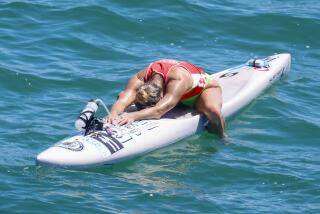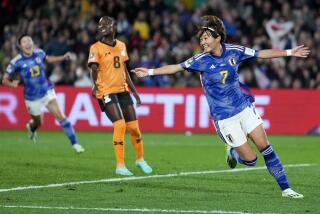Serious Sorting Out Resumes Tuesday in America’s Cup Trials
FREMANTLE, Australia — Although half a world away from friends and families, none of the yachtsmen here wants to be home for Christmas.
That’s the fate that awaits all but 4 of the 12 crews challenging for the right to wrest the America’s Cup from Australia. The other eight will be eliminated when points are tabulated at the end of the third round-robin series which starts Tuesday.
Since competition started Oct. 5 both fields have been well sorted out. The defender series is strictly among the Kookaburras II and III and Australia IV, while New Zealand and America II have dominated the challengers.
Dennis Conner’s Stars & Stripes slipped in the second round when the wind failed to blow but can be counted on for a comeback. Some of the others need miracles.
Neither Eagle’s Rod Davis, the youngest American skipper at 31, nor Buddy Melges, the oldest at 56, appears put off by the prospect of confronting the first-place New Zealanders, runner-up America II or Conner in the third spot. Davis and Melges must win at least 9 of 11 races to keep their semifinal hopes alive.
Eagle syndicate spokesman Michael Dinn says a new keel configuration will lift the team from ninth place and put it on a fast track.
“Our fat keel wings are gone away and, like the other fast boats, we’ll be riding on a surfboard in the next round,” he said.
“We’re going to prove we’re a whole lot better than everybody thinks,” Davis said.
Eagle decided it had to try something drastic halfway through the second round, on its way to an 8-15 record overall. Not everyone in the syndicate agreed, so sailing director Gerry Driscoll and shore operations manager Robin Fuger resigned.
“We’ve made a keel change that won’t look like any other,” Davis said. “The way we were headed just wasn’t going to get us into the top four.”
Melges also realizes the gravity of the situation. “We’re hanging it all out,” he said, anxious to test Heart of America after three feet were added to the width of the tips on the wings and ballast moved lower in the boat. “We can still make it.”
Even the more successful syndicates have been tinkering. Conner fell off the pace in the second round when he found that his Stars & Stripes, developed in the blustery breezes of Hawaii, couldn’t compete in winds of less than 12 knots. He hopes changes have made it more versatile.
Conner also is banking on the scheduled arrival of the “Fremantle Doctor,” the strong afternoon wind that cools Australia’s west coast in the Southern Hemisphere’s summer. Heat rising from the arid interior creates a vacuum effect that draws the air in from the Indian Ocean.
Sandy Purdon, executive administrator for Conner’s Sail America syndicate, said recent signs indicate the doctor is in.
“It’s been blowing 30 knots the last few days,” Purdon said.
America II skipper John Kolius said, “We’ve done a lot of things we think will give us some little gains.”
More than any other, the New York boat, dubbed the “Lego” boat early on, was designed to easily accept major changes, such as interchangeable keels.
Kolius said, “We don’t even know which combination we’ll use.”
USA, the radical San Francisco boat with rudders fore and aft, may have a new helmsman, Paul Cayard. Skipper Tom Blackaller switched roles with his tactician for the last six races of the second round but continues to call the shots.
The New York syndicate is better off financially than the others, but they’re all running on tight budgets or extended credit.
The challengers have about abandoned hope of overtaking upstart New Zealand, a first-time Cup competitor that has won 22 of its 23 races and has been dominant in the full range of weather conditions.
The Kiwis’ KZ7 is the only fiberglass 12-meter, and its aluminum rivals’ best hope may be that the craft will prove illegal, as Conner suggested earlier, when the surviving boats are rechecked before the semifinals.
Skipper Chris Dickson says, “We’re not so crazy as to go out there with an illegal boat. That would be absolutely stupid.”
Rather, he says, the Kiwis got a jump on other syndicates and what he calls their “tin boats” by developing three superior fiberglass craft, which Dickson says are “lighter, stiffer and stronger” than conventional aluminum boats. Then they spent nearly a year testing and tuning them on the waters where they would race until refining them into the ultimate KZ7.
“We’ve been in Fremantle since January,” Dickson said. “Eleven months, six days a week, we’ve learned to handle the boat.”
Unless somebody reels in the Kiwis, America will not even be competing for the America’s Cup in the challenge round in February.
America II seems secure in second, but Conner is being pressed for third by French Kiss, USA and Britain’s White Crusader.
Mathematically, everyone still has a chance to qualify for the semifinals. While each win was worth only one point in the first round and five in the second, they now jump to 12.
The defender trials also resume Tuesday with the third of four rounds and only five boats remaining. The Alan Bond syndicate withdrew fourth-place Australia III to focus its effort on Australia IV, which is running second to Kookaburra III, a jump ahead of Kookaburra II, and trying to head off an all-Kookaburra semifinal in January.
Gary Jobson, a former America’s Cup tactician who is ESPN’s expert analyst, thinks that Australia IV is virtually equal in speed to Kookaburra III but is losing out on tactics and boat handling.
“Aussie IV is closer to Kookaburra than the press has led people to believe,” Jobson said.
But one difference, Jobson says, is that Kookaburra skipper Iain Murray runs his whole show without interference from the top, while Australia IV’s Colin Beashel must deal with the indomitable Bond, whose persistence captured the Cup on his fourth try in 1983.
“I think Beashel’s been under a lot of pressure,” Jobson said.
Ben Lexcen, who designed the Bond boats, said: “My honest opinion is that Australia IV is a freckle faster off the wind than Kookaburra III and a little faster upwind in heavier breezes. Kookaburra II is faster upwind in lighter winds, but there is very little difference between the three.
“In the first series we were beaten in tacking duels by the Kookaburras, not because their boats were better, but because they had done so much practice with boats of equal speed.
“Our guys did not feel comfortable at close quarters and so they would tack away and look for good wind shifts. If we can get our boat going a little faster, they (Kookaburra III interests) have a problem. But we know they are not going to sit still, either.”
With the competition at the desperate stage, the sailing figures to be rough in tactics as well as weather. Some of the Australian boats were already bashing into one another in the previous round.
And, for the foreign challengers, the Christmas rush is on.


